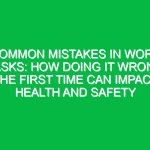Introduction
Process Safety Management, commonly referred to as PSSR (Process Safety System Review), plays a pivotal role in the Health, Safety, and Environment (HSE) domain. PSSR is not merely a regulatory requirement; it is a proactive approach to ensuring that processes within industries, particularly those handling hazardous substances, are conducted safely and sustainably. In this article, we will explore the essential steps involved in effectively implementing PSSR, the benefits it offers, and the regulations that govern it. Our journey will also include real-life insights and actionable advice, making this an essential read for professionals committed to enhancing HSE practices.
The significance of PSSR cannot be overstated. With industries increasingly facing scrutiny over safety practices, a robust PSSR process can lead to a reduction in accidents, improved compliance with regulations, and ultimately, a culture of safety that permeates throughout an organization. The following sections will delve deeper into how organizations can unlock the full potential of PSSR and what steps they must follow to ensure HSE success.
Understanding PSSR in the HSE Context
PSSR encompasses several key components that are crucial for effective safety management. At its core, PSSR is designed to evaluate the safety systems in place, identify potential risks, and implement improvements. The following aspects are integral to understanding PSSR within the HSE framework:
1. Definition and Purpose of PSSR
PSSR is a systematic approach to managing and mitigating risks associated with process safety. Its primary purpose is to ensure that any changes made to processes, equipment, or operations do not compromise safety. By conducting a thorough review, organizations can identify gaps in existing safety measures and enhance their protocols accordingly.
2. Key Components of PSSR
The PSSR process typically includes the following key components:
- Hazard Identification: Identifying potential hazards associated with processes.
- Risk Assessment: Evaluating the likelihood and impact of identified hazards.
- Control Measures: Implementing measures to mitigate identified risks.
- Training and Awareness: Ensuring that staff is trained to recognize and manage hazards.
- Documentation: Maintaining accurate records of processes, assessments, and improvements.
3. The Importance of a Safety Culture
A strong safety culture is fundamental to the success of PSSR. Organizations must foster an environment where safety is prioritized, and employees feel empowered to speak up about potential hazards. A case study involving a chemical manufacturing plant illustrates this point clearly. After facing a significant incident due to a lack of communication about safety concerns, the plant implemented a comprehensive PSSR framework. Employees underwent training, and regular safety meetings were instituted. Over time, the plant saw a marked decrease in incidents, emphasizing the importance of a proactive safety culture.
Steps to Implement Effective PSSR
Implementing PSSR is not a one-time activity but an ongoing process that requires commitment and diligence. Here are the essential steps organizations should follow:
1. Establish a PSSR Team
Forming a dedicated PSSR team is crucial. This team should consist of individuals from various departments, including engineering, operations, and HSE. The diversity within the team ensures that multiple perspectives are considered when evaluating processes.
2. Define Scope and Objectives
Clearly define the scope of the PSSR process. What specific areas will be reviewed? What are the objectives? Setting clear goals provides direction and helps in measuring success.
3. Conduct a Hazard Analysis
Utilize tools such as Hazard and Operability Study (HAZOP), Failure Modes and Effects Analysis (FMEA), and Fault Tree Analysis (FTA) to identify hazards. This analysis should be comprehensive, considering all potential scenarios that could lead to an incident.
4. Evaluate Existing Safety Systems
Review the current safety systems and procedures to assess their effectiveness. Are there existing gaps? Are current measures sufficient to mitigate the identified risks? This evaluation is crucial for identifying areas for improvement.
5. Develop Action Plans
Based on the findings from the hazard analysis and safety systems evaluation, develop actionable plans. These should include timelines and responsibilities for implementing improvements. It’s vital to prioritize actions based on the level of risk associated with each identified hazard.
6. Training and Communication
Training is an integral part of the PSSR process. All employees should be made aware of the hazards associated with their work and trained on the improved safety measures. Open lines of communication are crucial for ensuring that safety is a shared responsibility.
7. Continuous Monitoring and Review
PSSR is not a static process. Continuous monitoring of safety performance, regular reviews of procedures, and updates to training materials are essential to maintain effectiveness. Conduct periodic audits to ensure compliance with safety protocols and assess the impact of changes made.
Benefits of PSSR
Investing in a robust PSSR process yields numerous benefits for organizations. Here are some of the most significant advantages:
1. Enhanced Safety
The primary benefit of PSSR is the enhancement of safety within the workplace. By identifying and mitigating risks, organizations can prevent accidents and injuries, ultimately protecting their most valuable assets: their employees.
2. Improved Regulatory Compliance
Adhering to PSSR guidelines helps organizations comply with local and international regulations. This compliance not only avoids potential fines and legal issues but also enhances the organization’s reputation among stakeholders.
3. Increased Operational Efficiency
A focus on safety can lead to increased operational efficiency. By streamlining safety processes and ensuring that employees are well-trained, organizations can reduce downtime caused by accidents and incidents.
4. Positive Organizational Culture
When safety is prioritized, it fosters a culture of care and responsibility among employees. A positive safety culture leads to increased morale and productivity, contributing to overall organizational success.
Regulations and Standards Governing PSSR
Understanding the legal framework surrounding PSSR is essential for compliance and best practices. Several regulations and standards govern process safety management, including:
1. OSHA Standards
In the United States, the Occupational Safety and Health Administration (OSHA) has established standards for process safety management under 29 CFR 1910.119. These regulations require facilities to implement a process safety management system to prevent the release of hazardous substances.
2. EPA Regulations
The Environmental Protection Agency (EPA) also plays a significant role, particularly concerning chemical safety and environmental protection. The Risk Management Plan (RMP) rule requires facilities to develop and implement risk management programs to prevent chemical accidents.
3. International Standards
Organizations operating globally must also adhere to international standards such as ISO 45001 (Occupational Health and Safety Management Systems) and ISO 14001 (Environmental Management Systems). These standards provide frameworks for organizations to manage safety and environmental impacts effectively.
Conclusion
Unlocking the full potential of PSSR is essential for any organization committed to enhancing health, safety, and environmental practices. By understanding the key components of PSSR, following actionable steps for implementation, and adhering to relevant regulations, organizations can significantly improve their safety culture and operational efficiency.
In a world where safety cannot be compromised, it is vital for organizations to invest in effective PSSR processes. The benefits are not just regulatory compliance or improved efficiency; they extend to the welfare of employees and the sustainability of the environment. As we move forward, let us embrace PSSR not just as a requirement but as a fundamental pillar of our organizational ethos, fostering a culture where safety is everyone’s responsibility.


